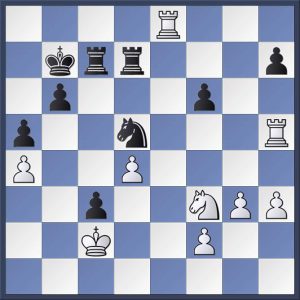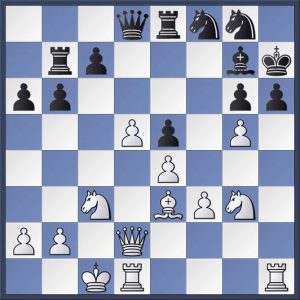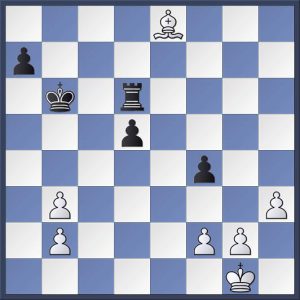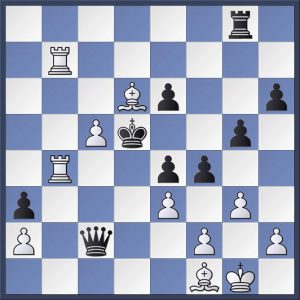
Cook vs. Parsons. This was the final position from the last game to finish in this year’s championship. White can put off the inevitable by sacrificing the exchange on d5 but Black will still be winning. Phil therefore resigned here leaving 5 players on 4 points with tie-break deciding the champion for the second year running
Another edition of the Calderdale Individual Chess Championship came to a close last Monday at the Trades Club. It’s been a fascinating competition this year with a number of the top seeds dropping draws and even stumbling to defeat in a couple of cases in the early rounds of the competition. That essentially cleared the way for the fourth seed, Phil Cook of Todmorden, to reach 4/4 after three consecutive wins against players from Hebden Bridge: Martin Syrett in Round 2, Nick Sykes in Round 3 and Dave Shapland in Round 4.
In the meantime some of the other leading players had been trying to make up ground on the leader but had been foiled by his continuing string of victories. Top seed and three-time champion, Matthew Parsons (Hebden Bridge) had overcome fifth seed John Allan (Hebden Bridge) and then drawn with sixth seed Ian Hunter (Belgrave) to stay within touching distance of the run-away leader and would now finally have the opportunity to catch him in the final round if he could beat him with the Black pieces to order. Failing to win would guarantee that Cook would win the trophy and even a defeat for the Todmorden player could still see him through on a tie-break if one or more of the other players besides Matthew Parsons reached 4 points as well.
If the top board game promised to be the most interesting game of the evening from the perspective of the final standings then some of the subsequent boards also promised some entertaining action. On board two ninth seed Pete Leonard (Hebden Bridge) had recovered from his surprise defeat in round 1 to beat the second seed and reigning champions Greg Eagleton (Huddersfield) in the fourth round. His reward was another tough assignment with the Black pieces against the undefeated Ian Hunter. On board 3 an all Hebden Bridge encounter between too of Phil Cook’s victims, Martin Syrett and Dave Shapland, promised to be an ‘uninhibited’ toe-to-toe encounter.
After that the draw was, unfortunately, adversely effected by a spate of final round withdrawals – which these days seem to be a disappointing inevitability in this competition. Greg Eagleton withdrew before the final round and his Huddersfield club colleague Mitchell Burke also failed to show up when he was due to play Richard Bedford (Todmorden), another of the players on 3 points.
There were a number of other match ups that promised some interesting and closely fought battles. On board 5 John Allan was paired against Steve Harrington (Belgrave) who had performed admirably to reach 2½/4. Allan played patiently in the opening against his opponent’s Accellerated Dragon variation of the Sicilian Defence. Exploiting some inaccurate play he won first one and then a second pawn to accumulate an overwhelming endgame advantage. This meant John finished on a respectable 3½/5 having drawn with Mike Barnett (Belgrave) in round 2 and been defeated by Matthew Parsons in round 3.
On board 6 Mike Barnett and Scott Gornall (Halifax) looked on paper like they would be very evenly matched and so it proved as they played on into an end game but neither player could secure an advantage and they each drew their second game of the competition to finish on 3 points.
Board 7 saw Andy Leatherbarrow (Hebden Bridge) face the seventh seed, Richard Porter (Halifax). It was Leatherbarrow who had ensured the top seed’s tournament had gotten off to a slow start when he held Matthew Parsons to a draw in round 1. He’d beaten a lower ranked player in round 2 but had then stalled somewhat himself with a half point bye in round three and a draw with Nick Sykes (Hebden Bridge) in round 4. Richard’s tournament meanwhile had been rather more topsy-turvey after he suffered a big upset at the hands of club colleague Pete Moss in round 1 and then lost another game to a lower ranked player, Martin Syrett, in round 4.
It looked like it would be another very stiff test for the Halifax player and indeed in the early stages of the game Andy played sensible, solid chess and slowly built up a small advantage. At move 22 White still stood better but then it looked like Andy followed the wrong plan by advancing his h-pawn and in a couple of moves the advantage swung to his opponent who was able to see out the win and finish on 3 points.
On the lower boards there was still something to play for in the form of grading prizes and the Hebden Bridge junior contingent were battling it out for their prize as well.
On board 8 Pete Moss (Halifax) rounded off a fine tournament for him by beating Vivienne Webster (Halifax) with the Black pieces to reach 3 points. Barry Wadsworth and Daniel Rivron (both Halifax) fought each other to a stand-still to finish on 50% and Robert Sutcliffe (Huddersfield) defeated Bill Joyce (Todmorden).

Bedford vs. Dawson. White to play. Richard has a very promising initiative here. How should he proceed? See how many of the subsequent lines you can calculate after finding White’s next move.
The juniors were playing against each other on the bottom boards. Gwilym Hughes scored his second win of the competition against Alfie Dermo and in a battle of the siblings Joel Hadari managed to beat his sister Juliet for his first point in the competition. Martha Leggett was unlucky once again as her opponent didn’t appear and there was no-one to pair here against. She’s picked up two defaults in this fashion which is a shame.
That just leaves us with the business end of proceedings to cover off. On board 4 Richard Bedford (Todmorden) was the first of the players in with a chance of pulling level with Phil should he be defeated. He had been due to face Mitchell Burke (Hudderfield) but when Mitchell didn’t make an appearance he was re-paired with Adrian Dawson (Belgrave). That should have been an easier proposition for Richard and so it turned out to be as he played, with White, a nice Anti-Grunfeld where the players castled on opposite sides of the board. Richard’s attack was always looking quicker however and he broke through to give checkmate with some pleasing pyrotechnics. This made him the second player (after Phil) to reach 4 points.

Syrett vs. Shapland. Martin Syrett has two pawns for the exchange having just traded queens on e8. How should Black now proceed and what should the result be with best play? Find out the answer in the game viewer at the end of this post.
On board 3, Hebden Bridge ‘A’ and ‘B’ team captains, Dave Shapland and Martin Syrett were also battling it out to reach 4. These two are uncompromising characters at the board and their games are usually full of fight and attack. This game, full of ebb and flow, did not disappoint on that score. Dave chose to play the French Defence as a surprise weapon and Martin soon veered from the most well-trodden paths of the Tarrasch Variation to ensure the game would reach an original position early on.
Dave got himself in a tangle and soon it looked like Martin had managed to stir up an overwhelming attack. However, the Black position proved to be more resilient than it appeared and Dave was able to repulse the White pieces and launch a counter offensive. This in turn looked dangerous and provoked Martin to sacrifice an exchange for two pawns and the initiative.
With Dave’s king bobbing about in the open and Martin’s rook and queen infiltrating the Black camp it seemed Martin might have at least enough for a draw but then, late on in the evening, with both players weary from an exhausting battle, Martin chose to exchange queens not seeing that the resultant ending of bishop and five pawns versus rook and three pawns was losing for him almost immediately via a tactical trick. Dave has had a number of lucky escapes against lower rated opponents in this year’s competition but nevertheless managed to reach 4 points.

Hunter vs Leonard. Black has just played 44…f4? which unfortunately allows an attractive check mate. How long will it take you to spot it?
On board 2 Ian Hunter and Pete Leonard also played a very interesting and complicated game which saw Pete playing his habitual choice against the English opening 1…b6. The game then looks like it transposed in to something akin to a Catalan. Pete, like Dave, has provided extensive annotations of this game in the viewer at the end of this report and the game is well worth playing through as both players fought in uncompromising fashion for an unbalanced position that would be most likely to produce a decisive result.
At one point Pete seemed to have the advantage and Ian offered an exchange sacrifice to try and stay afloat. Pete declined it, preferring instead to lock his bishop in on b2 with his advanced a-pawn providing support. Soon after that though, as Pete admitted himself, he started to lose his way and when he declined two subsequent pawn offers by Ian, White seized the advantage by sacrificing his queen for a rook and bishop!
The subsequent play was highly complicated with Ian holding passed b and c-pawns as part of his perfectly adequate compensation for the material. Both players went astray at times in the murk that followed but it was Ian who ended up on the winning side after Pete wandered his king into an attractive mating net. With this Ian became the fourth player to reach 4 points.
All of this now meant that the battle on board 1 was irrelevant as far as deciding the destiny of the title was concerned. Phil’s ‘sum of consecutive scores’ tie break was already better than Ian, Dave or Richard’s and would also be better than Matthew’s even if he lost. Never the less, Matthew showed great fighting spirit to play for victory with Black in a game he had to try and win even though he knew even that would probably not be enough to re-take the title he last won in 2015.
Purely from an accuracy perspective, this final game of the competition was probably one of the best played in all 5 rounds. It certainly compares well with Matthew’s fine win with the Black pieces against John Allan in round 3. Once again he played it patiently and slowly took advantage of Phil’s natural desire to play it safe in a game that he only needed to draw. Even in the game notes that he has provided Matthew finds it hard to pinpoint exactly where Phil went wrong as he slow neutralised any White winning chances and then went onto the offensive.
In the end game only Black had winning chances and Matthew patiently manoeuvred his pieces, including his king to their optimum squares and then prepared a pawn break through on the queen’s side. At the end Phil could have sacrificed the exchange to limp on but it was evident that would only prolong his agony and by that stage of the evening it was evident he had won the championship in any case.
The final results show a 5-way tie for first but with Phil Cook champion on the ‘sum of progressive scores’ tie-break. Congratulations to Phil on his maiden Calderdale Individual title. Dave Shapland finished second. Ian Hunter and Matthew Parsons were the only two unbeaten players in the competition but they did each draw twice. Ian at least had the consolation of a grading prize. Matthew had to content himself with having played the best chess in the tournament and having had the toughest schedule as he beat both John Allan and Phil Cook and draw with Ian. These three players were seeded 6, 5 and 4 respectively.
The fifth player to score 4 points was Richard Bedford. He was also the lowest rated to reach this score which was a highly creditable outcome. Unfortunately, he just missed out on a grading prize as he was in the same banding as Ian who edged him on tie-break.
The other grading prizes were won by Mike Barnett, Pete Moss and Gwilym Hughes. Martha Leggett took the junior prize.
A full list of the final scores is given below:
4 points = P.Cook (1st), D.Shapland (2nd), M.Parsons, I.Hunter (Grading prize), R.Bedford
3½ points = J.Allan
3 points = R.Porter, P.Leonard, M.Syrett, S.Gornall, M.Barnett (Grading prize), P.Moss (Grading prize), M.Leggett (Junior prize)
2½ = G.Eagleton, M.Burke, N.Sykes, A.Leatherbarrow, D.Rivron, B.Wadsworth, S.Harrington
2 = J.Lavan, R.Sutcliffe, V.Webster, N.Bamford, A.Dawson, G.Hughes
1½ = A.Gonzalez, L.Curry, T.Dodd
1 = B.Joyce, J.Y.Hadari, B.J.S.Hadari
½ = M.J.Tait
0 = A.Dermo
Withdrew = J.Brooke, T.Sullivan, M.O’Keefe
A selection of games from the final round can be found in the game viewer below. The top three games all come with commentary from Matthew Parsons, Pete Leonard and Dave Shapland respectively.
All that remains is for us to express our gratitude to the tournament organizer and controller, John Kerrane who once again presided over a well-attended and smoothly run competition.
Great report and thoroughly enjoyable tourney! I was somewhat lucky in the end having been drawn against lower rated players than the others on 4/5, similar to last year where I also got 4/5 but didn’t meet many of the big guns. Congrats to Phil and to all who took part in the event, huge thanks also to John for his tireless work as ever.
Ditto! 🙂
Shame I couldn’t play in the last round but enjoyed it nevertheless!
Enjoyed your reports on Calderdale Champs thought I would give input as a neutral outsider. Looking at the tourney it is so big now, perhaps its should be split into two sections top 16 on rating, then the rest with prospects of say 4 promoted from group B as an incentive and 4 down from group A so everyone has something to play for at end of season. As it stands at moment 1/3 of the field were not playing at end of tourney for various reason,one of which I believe is nothing to play for in round 5 for many players.
This is a good point. It would be nice if some of the sub 150 players actually had something to play for.
Its need to be more than ‘just another game. ‘
I also think we have the time in the year to play a couple more rounds.
Something does need to be done to address the withdrawals.
I think that is an interesting point indeed. I must confess I also found a grading band that included players in the mid 140’s and players as high as 174 a little wide but I guess there has to be a line drawn somewhere!